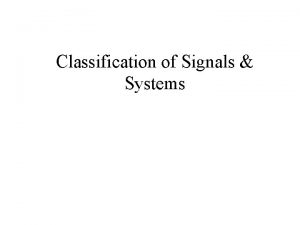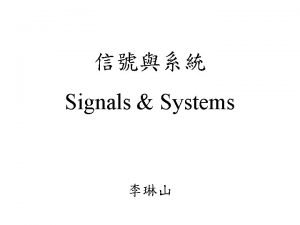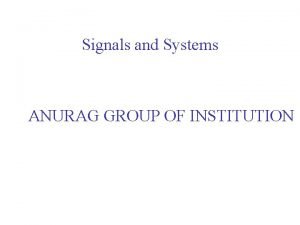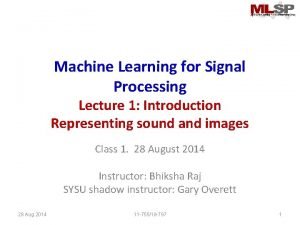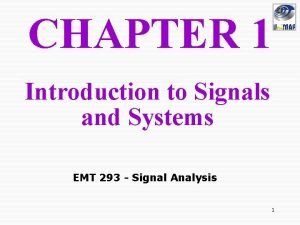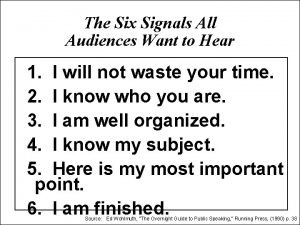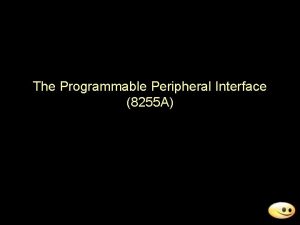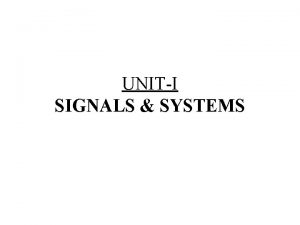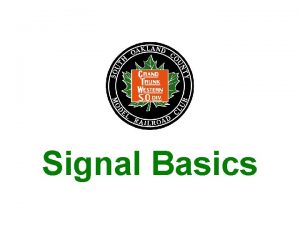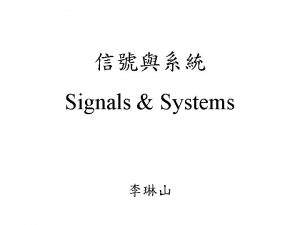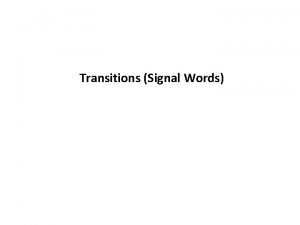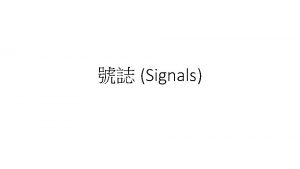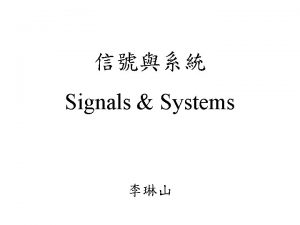Classification of Signals Introduction to Signals A Signal































- Slides: 31

Classification of Signals

Introduction to Signals • A Signal is the function of one or more independent variables that carries some information to represent a physical phenomenon. e. g. ECG, EEG • Two Types of Signals 1. Continuous-time signals 2. Discrete-time signals

1. Continuous-Time Signals • Signal that has a value for all points in time • Function of time – Written as x(t) because the signal “x” is a function of time • Commonly found in the physical world – ex. Human speech • Displayed graphically as a line 3

2. Discrete-Time Signals • Signal that has a value for only specific points in time • Typically formed by “sampling” a continuous-time signal – Taking the value of the original waveform at specific intervals in time • Function of the sample value, n – Write as x[n] – Often called a sequence • Commonly found in the digital world – ex. wav file or mp 3 • Displayed graphically as individual values – Called a “stem” plot Sample number 4

Examples: CT vs. DT Signals 5

Discrete-Time Signals • Sampling is the acquisition of the values of a continuous-time signal at discrete points in time • x(t) is a continuous-time signal, x[n] is a discretetime signal

Deterministic & Non Deterministic Signals Deterministic signals • Behavior of these signals is predictable w. r. t time • There is no uncertainty with respect to its value at any time. • These signals can be expressed mathematically. For example x(t) = sin(3 t) is deterministic signal.

Deterministic & Non Deterministic Signals Contd. Non Deterministic or Random signals • Behavior of these signals is random i. e. not predictable w. r. t time. • There is an uncertainty with respect to its value at any time. • These signals can’t be expressed mathematically. • For example Thermal Noise generated is non deterministic signal.

Periodic and Non-periodic Signals • Given x(t) is a continuous-time signal • x (t) is periodic iff x(t) = x(t+Tₒ) for any T and any integer n • Example – x(t) = A cos(wt) – x(t+Tₒ) = A cos[w(t+Tₒ)] = A cos(wt+w. Tₒ)= A cos(wt+2 p) = A cos(wt) – Note: Tₒ =1/fₒ ; w=2 pfₒ

Periodic and Non-periodic Signals Contd. • For non-periodic signals x(t) ≠ x(t+Tₒ) • A non-periodic signal is assumed to have a period T = ∞ • Example of non periodic signal is an exponential signal

Important Condition of Periodicity for Discrete Time Signals • A discrete time signal is periodic if x(n) = x(n+N) • For satisfying the above condition the frequency of the discrete time signal should be ratio of two integers i. e. fₒ = k/N

Sum of periodic Signals • • X(t) = x 1(t) + X 2(t) X(t+T) = x 1(t+m 1 T 1) + X 2(t+m 2 T 2) m 1 T 1=m 2 T 2 = Tₒ = Fundamental period Example: cos(tp/3)+sin(tp/4) – T 1=(2 p)/(p/3)=6; T 2 =(2 p)/(p/4)=8; – T 1/T 2=6/8 = ¾ = (rational number) = m 2/m 1 – m 1 T 1=m 2 T 2 Find m 1 and m 2 – 6. 4 = 3. 8 = 24 = Tₒ

Sum of periodic Signals – may not always be periodic! T 1=(2 p)/(1)= 2 p; T 2 =(2 p)/(sqrt(2)); T 1/T 2= sqrt(2); – Note: T 1/T 2 = sqrt(2) is an irrational number – X(t) is aperiodic


Even and Odd Signals Even Functions Odd Functions

Even and Odd Parts of Functions A function whose even part is zero, is odd and a function whose odd part is zero, is even.

Various Combinations of even and odd functions Function type Sum Difference Product Quotient Both even Even Both odd Odd Even Neither Odd Even and odd Neither

Derivatives and Integrals of Functions Function type Derivative Integral Even Odd + constant Odd Even

Discrete Time Even and Odd Signals

Combination of even and odd function for DT Signals Function type Sum Difference Product Quotient Both even Even Both odd Odd Even or odd Odd Even and odd Even or Odd

Products of DT Even and Odd Functions Two Even Functions

Products of DT Even and Odd Functions Contd. An Even Function and an Odd Function

Proof Examples • Prove that product of two even signals is even. • Prove that product of two odd signals is odd. • What is the product of an even signal and an odd signal? Prove it! Change t -t

Products of DT Even and Odd Functions Contd. Two Odd Functions

Energy and Power Signals Energy Signal • A signal with finite energy and zero power is called Energy Signal i. e. for energy signal 0<E<∞ and P =0 • Signal energy of a signal is defined as the area under the square of the magnitude of the signal. • The units of signal energy depends on the unit of the signal.

Energy and Power Signals Contd. Power Signal • Some signals have infinite signal energy. In that caseit is more convenient to deal with average signal power. • For power signals 0<P<∞ and E = ∞ • Average power of the signal is given by

Energy and Power Signals Contd. • For a periodic signal x(t) the average signal power is • T is any period of the signal. • Periodic signals are generally power signals.

Signal Energy and Power for DT Signal • A discrtet time signal with finite energy and zero power is called Energy Signal i. e. for energy signal 0<E<∞ and P =0 • The signal energy of a for a discrete time signal x[n] is

Signal Energy and Power for DT Signal Contd. The average signal power of a discrete time power signal x[n] is For a periodic signal x[n] the average signal power is


Thank you
 Communicative signals and informative signals
Communicative signals and informative signals Arbitrariness in human language and animal language
Arbitrariness in human language and animal language Communicative and informative signals
Communicative and informative signals Baseband signal and bandpass signal
Baseband signal and bandpass signal Baseband signal and bandpass signal
Baseband signal and bandpass signal Digital signal as a composite analog signal
Digital signal as a composite analog signal Classification of signals
Classification of signals Tri function
Tri function Classification of signals
Classification of signals Aperiodic signal
Aperiodic signal What is signal
What is signal Signal words of classification
Signal words of classification Simple listing pattern
Simple listing pattern What are the signal words
What are the signal words Introduction to signals and systems
Introduction to signals and systems Signal words for introduction
Signal words for introduction Remarks on lazy and eager learning
Remarks on lazy and eager learning Classification and tabulation
Classification and tabulation Traditional classification vs modern classification
Traditional classification vs modern classification Mainframe computer definition and examples
Mainframe computer definition and examples Conclusion paragraph format
Conclusion paragraph format Oath rope signals
Oath rope signals Oath rope signals
Oath rope signals Line judge volleyball signals
Line judge volleyball signals Water polo referee signals
Water polo referee signals Hockey unsportsmanlike conduct signal
Hockey unsportsmanlike conduct signal Unit 10 customer service
Unit 10 customer service Grammatical signals meaning
Grammatical signals meaning Safe signal baseball
Safe signal baseball 6 signals
6 signals 8255 features
8255 features William g morgan
William g morgan







